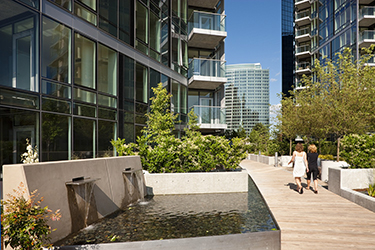|
Subscribe / Renew |
|
|
Contact Us |
|
| ► Subscribe to our Free Weekly Newsletter | |
| home | Welcome, sign in or click here to subscribe. | login |
Environment
| |
 |
February 27, 2014
LEED vs. Green Globes: How to choose
MulvannyG2 Architecture

Hand
|
The LEED vs. Green Globes battle isn’t new, but recent changes with these building rating systems have renewed debate about the comparative pros and cons of these systems. This article is designed to help you select the right certificate program for your project.
But first, the news: The U.S. General Services Administration recently elevated Green Globes to the same status as LEED as the two recommended third-party certifications systems for the U.S. government.
Though the announcement is specific to government work, it will affect the entire building industry by creating much-needed competition in the green-building certification marketplace. Additionally, the Green Building Initiative, which administers Green Globes in the U.S., has recently appointed Jerry Yudelson as its president. A prominent green-building advocate, Yudelson’s move to Green Globes caused a sensation partly because he’s a LEED Fellow.
This move seeks to put a new face on the often criticized company. Green Globes has been accused of being too cozy with industries, especially plastics and timber. Its board of directors includes members of the American Chemistry Council, the American Wood Council, Dow Chemical, and the Vinyl Institute, and the past president was a timber lobbyist.
But that image seems to be changing now that Yudelson is on board. Changes are also in the works for the board as well.
Meanwhile, LEED v4 was rolled out in November. While the changes to Green Globes are positive, LEED dominates the marketplace. There are more than 44,000 LEED buildings in the U.S. alone compared with an estimated 800 for Green Globes. LEED v4 will further continue LEED’s control in the certification landscape as LEED 2009 approaches its sunset date.
New market sectors covered in v4 include data centers, warehouses and distribution centers, hospitality, existing schools, existing retail and mid-rise residential projects. New impact categories include climate change, human health, water resources, biodiversity, green economy, community and natural resources.
Changes also include simplified credit submittal requirements and a new technology platform. Updates are designed to help owners and building managers meet their building’s full performance potential.
Consider your needs
Client demand driven by a desire for lower operating costs, market advantage, and/or social/ecological responsibility are steering the industry towards more sustainable building processes. The business case is clear: sustainable buildings can increase value by reducing risk across a building portfolio, lowering operating expenses, raising rental/lease rates, increasing occupancy rates, boosting market advantage, increasing ecological/social responsibility, and sometimes even lowering yields (capitalization/discount rate).
However, the greater the level of certification, the higher upfront capital costs. If the goal is to build more towards the triple bottom line, then choosing the right system and certification level for your needs and budget deserves attention.
As the younger of the two systems, Green Globes needs to increase its visibility as well as instill trust in the marketplace that its certification provides as much value as LEED. While the recent changes in leadership have helped the program’s reputation, only time and the market can define its ultimate value.
Though side-by-side comparisons are difficult since each project is unique, here are some general guidelines:
Price:
• The consensus is that LEED is more costly than Green Globes in terms of the consultant fees required to navigate the process. The lower certification levels for most buildings add up to 4 percent in design and construction costs compared to a standard building while projects reaching for net zero can cost up to 13 percent more.
Project fees for Green Globes can be higher than LEED’s, but it is generally observed that this process takes significantly less time to navigate for your consultants.
Ease of use:
• LEED is a complex rating system that can affect all disciplines during the design and construction process. It also requires the use of extensive exhibits to verify compliance and results.
This process requires consultants to have an understanding of not only how the rating system can affect their work, but how the work of the team is interconnected throughout the credit categories. Many owners and developers are now using specialty LEED consultants just to manage the certification process while relying on other consultants (architects, engineers, designers, etc.) to be well-versed in the system to ensure a satisfactory outcome.
• Benefits claimed by Green Globes include a transparent process, a Web-based survey, customer support, use of third-party assessors, and a less onerous bureaucratic process than LEED.
Green Globes also has free associate membership, no appeal costs and fewer registration costs. The process of certification involves a preliminary online assessment followed by an on-site assessment by a Green Globes representative.
Sustainable impact:
• LEED has historically had more stringent standards and, as with LEED v4, continues to revise and adapt its certification to the market.
• Green Globes has been approved by the General Services Administration as an equivalent certification system to LEED.
• LEED accepts only one sustainable forest certification.
• Green Globes accepts four sustainable forest certifications.
Scoring:
• LEED’s four certification levels include certified, silver, gold and platinum. The scoring is based on a 110-point program. LEED v4 has nine credit categories for new construction including integrative process; location and transportation; sustainable sites; water efficiency; energy and atmosphere; materials and resources; indoor environmental quality; innovation; and regional priority.
• Green Globes awards one to four globes based on a 1,000-point program. Green Globes assessment areas cover site, energy, water, emissions, project management, indoor environment, and materials and resources.
Looking forward
It’s important to remember that the certification program does not make the building. There are plenty of examples of certified buildings from a variety of vendors that have failed to live up to expectations.
Additionally, seeking third-party verification and acknowledging the sustainability efforts may not be the best choice or in the budget for all projects. However, if a certification program is selected it is important that the owner, contractor and all consultants are on board and in agreement in order to make the certification process run smoothly. (This is equally important even when pursuing sustainable goals without certification.)
When selecting a consultant for your certification program be sure to do your research. Some important questions and items to consider include:
• Ask if the MEP has experience filling out the various jurisdiction forms (CALGreen, LEED, etc.) and can provide the modeling/energy calculations required.
• Ask the commissioning agent if you can view a sample of a recent commissioning plan similar to the project type you’re working on.
• Ask the green consultant if he or she has experience putting together the owner’s project requirements or the Basis of Design on similar projects.
• Check to see if the architect or spec writer is knowledgeable about accepted materials (recycled, low-VOC content, etc.).
Using a building rating system can pay off in terms of lower operating costs, environmental benefits and even marketing. But to fully realize these benefits, you should first educate yourself on the differences between systems so you can choose the best one for your goals.
Stuart Hand is an associate at MulvannyG2 Architecture.
Other Stories:
- Investing in green spaces can pay off for property owners
- How transparency can change the game on green building
- LEED shifts focus from design to performance
- LEED is here to stay so long as owners find it useful
- Old warehouse now a super-efficient office building
- U.S.-Mexico border crossing gets a net-zero makeover
- King County to try new rating system for infrastructure
- Historic rehab a test for performance-based codes
- Stone34 to put its deep green bona fides to the test
- No guts, more glory: Why it pays to go minimal
- State seeks to wring more value from its projects



